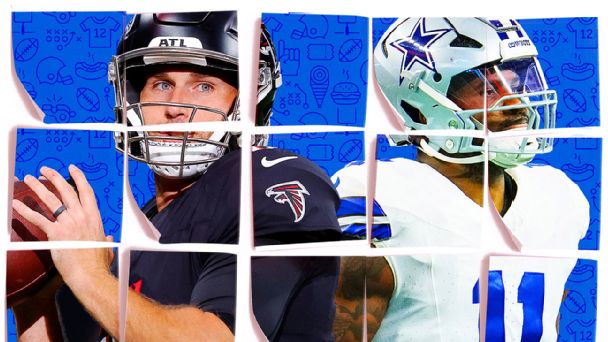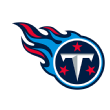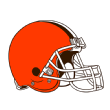2025 NFL mock draft with all trades: Deals for Round 1 picks

I'm so glad it's that time again. To you, mock draft season might mean reading the insights of ESPN's Mel Kiper Jr., Field Yates, Jordan Reid and Matt Miller, who use their film study and sources in the league to forecast who your favorite team will select in the NFL draft. For me, it's a chance to put together my most ridiculous and enjoyable column of the year.
Yes, it's time for the mock draft of trades. Most mocks have no trades, because as hard as it is to predict where players will actually end up, it's downright impossible to project which teams will make moves up and down and impact the draft order. This mock leans all the way into that uncertainty. For 32 picks, I have 32 trades occurring in 32 different universes. The trade I project with the No. 1 pick doesn't take place in the universe in which the No. 2 pick gets traded, and on and on.
The vast majority of the first 32 picks aren't going to be traded. (Right now, none of those selections has been swapped.) With each trade, the goal is to capture a scenario that might compel a team to make a move on draft day. What happens if quarterback Shedeur Sanders falls out of the top 10? What if there's a run on offensive linemen in the top six? And, with so many players being rumored to be trade candidates, what happens if edge rusher Trey Hendrickson, wideout George Pickens and even pass rusher Micah Parsons were involved in deals?
Subscribe: 'The Bill Barnwell Show'
To make the deals more plausible, I'm using the Jimmy Johnson chart, which NFL teams use to communicate the value of potential picks with one another. Given that this is a draft class without many top-tier quarterback prospects, most of these deals slightly favor the team moving up, since they don't have to pay the same premium compared to when there's more demand for top prospects.
I'm also taking into account the draft history of established general managers who have used their capital to inform their decisions, although those paths are murkier than they were with prior generations of executives. For example, Kwesi Adofo-Mensah had mostly traded down during his time as Vikings general manager, which was in line with an exec with an analytics-heavy background. Last year? He went all-in for quarterback J.J. McCarthy and edge rusher Dallas Turner and traded way up. I'll lean into how execs typically approach the draft, but there are always exceptions when scouts and coaches fall in love with players.
Picks in this draft will be denoted with the round and overall pick number, so if you see "2-38," that means the No. 38 overall selection, which comes in Round 2. Future picks are mentioned by round since we don't know exactly where they'll land.
Let's start with the No. 1 pick, which is always the most difficult one of the bunch. I firmly believe the Titans are drafting Cam Ward, but what if they're not as into the quarterback as it seems?
Jump to a team's first-round pick:br/>ARI | ATL | BAL | BUF | CAR | CHI | CINbr/>CLE | DAL | DEN | DET | GB | HOU | INDbr/>JAX | KC | LAC | LAR | LV | MIA | MINbr/>NE | NO | NYG | NYJ | PHI | PIT | SFbr/>SEA | TB | TEN | WSH


1. Tennessee Titans
Most years with this piece, the first paragraph you read after the trade details for the top pick is an apology. Because no, that trade usually is never going to happen. Most years, there would be something like Brock Purdy for the first overall pick here, serving as more of a thought exercise than a plausible deal.Things aren't quite as clear in this draft.
The Titans appear to be leaning toward drafting a quarterback, given their only addition under center this offseason has been veteran Brandon Allen. Cam Ward (Miami) seems to have separated himself from Shedeur Sanders (Colorado), but it's tough to find a consensus in the league that he's anything close to a no-doubt solution. There are superstars available at critical positions elsewhere in this draft, and the Titans aren't one player away from competing.
What if they're bluffing? What if the Titans aren't sure about Ward and have more confidence in adding edge rusherAbdul Carter (Penn State) or wide receiver/cornerback Travis Hunter(Colorado)? Instead of adding Ward to solve their quarterback problem, what if there's a veteran who could step in under center in the short term while they wait to find a prospect they like?
The purpose of bluffing would be to get the Browns to pay up for the privilege of ensuring that they'll get Ward. This played out in 2017, when the 49ers had no intention of drafting QBMitch Trubisky with the second overall pick. They still convinced the Bears they were willing to trade the pick to someone else who wanted Trubisky and landed two third-round picks and a fourth-rounder for moving down to No. 3. Two of those picks became Alvin Kamara and Fred Warner, who ended up being much more productive in the NFL than Trubisky.
So here, the Browns send a third-round pick and their second-rounder in 2026 to move up one spot, and they get back a sixth-round pick in next year's draft. It's a similar premium to what the Bears paid to move up one spot for Trubisky. Cleveland won't want to sacrifice picks, but when a franchise quarterback is involved, teams usually don't let a stray selection or two stand in the way of getting a deal done.
The Falcons would unload their wildly expensive backup quarterback in Cousins, whose $10 million roster bonus for 2026 was guaranteed earlier this month. With Cousins due $37.5 million between his 2025 base salary and 2026 bonus, the Falcons would eat $25 million to get this deal done, saving them the remaining $12.5 million. They would also get a Day 3 pick, which would seem generous since they clearly have no use for Cousins. The rules for underwater quarterback contracts, however, are different than the rules for players at every other position.
As for the Titans, if they aren't interested in Ward (or Sanders), Cousins allows them to take a shot on a quarterback who was playing reasonably well before he suffered a midseason shoulder injury. Through Week 9, he ranked 12th in Total QBR, nestled between Matthew Stafford and Jared Goff. He was averaging nearly 8.0 yards per attempt and had thrown 17 touchdown passes against seven picks. Cousins would be a rental for 2025 and potentially 2026 who buys the Titans some time to land on a better long-term solution than Ward.
And while moving down, the Titans would ensure themselves an elite prospect at one of the most expensive positions in football. With the Browns moving up for a quarterback, Tennessee would be ensured its pick of the rest of the draft, with Carter and Hunter as the potential targets. Carter would immediately become their best edge rusher and give the Titans an actual position of strength along their defensive line, with Jeffery Simmons and T'Vondre Sweat forming an excellent tackle duo. Hunter would start at cornerback across from L'Jarius Sneed and afford the Titans the ability to play man coverage more often in 2025. With little on the depth chart after Calvin Ridley, Hunter would also see reps at wide receiver.
Is this likely? Of course not. The Titans let backup quarterback Mason Rudolph leave and signed pass rusher Dre'Mont Jones to a one-year deal to replace Harold Landry III, which suggests they're likely targeting Ward at No. 1. Even if they weren't taking Ward, the Browns might not take the bait. The Falcons are telling everyone who will listen that they want to keep Cousins. Again, I would be surprised if the Titans traded out of the top spot. I would just be less surprised than just about any other year.

2. Cleveland Browns
In every way imaginable, the Deshaun Watson trade has been a disaster for the Browns. There's a lot of focus on how Watson's fully guaranteed deal has impacted Cleveland's salary cap, but what's not often discussed are the missing players from the Browns' roster. They traded three first-round picks and six total selections to the Texans for Watson in 2022. While Houston moved around the draft, Cleveland's traded first-round picks turned into Eagles defensive tackle Jordan Davis, Lions running back Jahmyr Gibbs and Jaguars wide receiverBrian Thomas Jr., each of whom are on cheap rookie deals.
The Browns undoubtedly want to add a star player with the No. 2 pick, but they need more cost-controlled talent across the board because of the aftereffects of the Watson trade. Moving down and adding extra picks makes sense, especially if they can add another 2026 selection. By dropping down four spots, they could still draft an impact player at No. 6, land another top-40 pick and get a buy-low candidate in Mayer, who would pair well with David Njoku.
For the Raiders, this is their chance to add a transcendent player.Travis Hunteris probably not making it to No. 6, and new coach Pete Carroll -- a legendary defensive backs coach -- has been know to defy positional value if there's a player he really loves in the secondary. (Remember, he once traded two first-round picks for Jamal Adams.) Hunter would be an immediate hit at cornerback, and I'm sure Carroll would have few qualms about putting Hunter at wide receiver as well. Las Vegas would also land a conditional pick that could turn into a fourth-rounder in 2027 if Mayer, who was drafted two regimes ago, racks up 600 receiving yards over the next two seasons in Cleveland.

3. New York Giants

If Ward and Sanders come off the board with the top two picks, the Giants would find themselves in a difficult predicament. The clear top player available would beAbdul Carter, but they have Brian Burns and Kayvon Thibodeaux in starting roles. They could takeTravis Hunter, but after drafting wideout Malik Nabers last year and signing Paulson Adebo this offseason, they aren't crying out for help at either of Hunter's positions. He'd still be a valuable addition, but New York should be focused on a quarterback of the future and offensive line help.
The Panthers, on the other hand, have one of the league's least imposing depth charts on the edge. New signing Pat Jones II had seven sacks last season, but he had just five in three previous seasons. Jadeveon Clowney is 32 years old and in the final year of his contract. Carter would be a building block for Carolina next to Derrick Brown, who missed most of the 2024 campaign with a meniscus injury.
Giants general manager Joe Schoen is trying to add players who can help immediately in light of dismal back-to-back years, but adding a second-round pick in this draft (via the Rams) and a second-rounder in 2026 from a team that has struggled the past few years is a worthwhile risk. That Panthers' second-rounder could be valuable if the Giants want to flip it later in this draft for a player who can help them this season.

4. New England Patriots
In a draft without many upper-echelon receiving prospects, the Patriots could try to cut the line and get quarterback Drake Maye a running mate alongside new signing Stefon Diggs. They were reportedly interested in Aiyuk a year ago, and despite his extension with the 49ers, rumors about his availability have continued this spring.
San Francisco would lose only about $7.2 million in cap space if it traded Aiyuk, which is a manageable amount. The move would also free up cash and future cap for the 49ers, who are clearly preparing for life with a very expensive iteration of Brock Purdy. They also have enough playmakers on offense with Jauan Jennings, Ricky Pearsall, George Kittle and Christian McCaffrey.
In this scenario, the 49ers could draft Hunter, who would appeal to both Shanahan, an offensive mastermind, and defensive coordinator Robert Saleh. Remember that Saleh turned around his Jets defense by drafting Sauce Gardner, who was an instant superstar corner after being taken with the No. 4 pick in 2022. Hunter would fill a huge hole for the 49ers, a position we've seen the franchise previously prioritize with free agent signings such as Richard Sherman and Charvarius Ward.
And isn't Shanahan the perfect coach to find spots for Hunter in 10-15 snaps a game? The 49ers have been extremely aggressive in pursuing players whom they see as transcendent difference-makers, even if it means paying premiums to acquire them. This was the same franchise that once suggested it would have taken Reuben Foster at No. 3 overall. It also traded three first-round picks to the Dolphins for Trey Lance. If the 49ers love Hunter, they might throw positional value by the wayside.
Moving up from No. 11 to No. 4 is equivalent to the No. 35 pick in a typical draft by the Johnson chart. The 49ers would essentially be treating the difference between the two players in this draft as that second-rounder. Strange would be a buy-low candidate along the offensive line, a 2022 first-rounder from the Bill Belichick era who has failed to impress amid injuries. The Patriots shouldn't be desperate to trade away offensive linemen, but after trying Strange at center last season, they signed Garrett Bradbury in free agency, suggesting they don't think Strange is their pivot of the future.
Having signed Diggs to a three-year deal, the Patriots would go from having the league's worst receiving corps to one with top-10 potential overnight. Diggs' deal has only $26 million guaranteed, which suggests he might be on the move as early as next offseason. Aiyuk, 27, would be around for years to come as part of a four-year deal with $110 million remaining. By moving down to No. 11, New England would hope to still be in position to add Will Campbell (LSU) or Armand Membou (Missouri) to its offensive line. Landing a left tackle, Diggs and Aiyuk would represent a dream offseason for Maye and the Pats.

5. Jacksonville Jaguars

With two third-rounders and two fourth-rounders, the Jaguars don't need to trade down and accumulate more picks. They've been commonly linked to defensive tackleMason Graham(Michigan) here, and that makes sense given their interior pass-rush struggles last season. I just get the feeling first-year head coach Liam Coen will help out Trevor Lawrence with his first-round pick. The No. 9 pick could be the spot in which running back Ashton Jeanty (Boise State) or tight end Tyler Warren (Penn State) is still on the board.
The Jags could upgrade one of their fourth-rounders to a pick in the first 10 of the second round. The Saints would jump ahead of the Raiders and Jets, meanwhile, to make sure they land Shedeur Sanders. While the Raiders (Geno Smith) and Jets (Justin Fields) both added quarterbacks this offseason, last year's Falcons proved that teams aren't opposed to adding a veteran quarterback and then drafting a long-term replacement.
With the Derek Carr era likely ending in New Orleans after this season, Sanders would step in as the new face of the franchise. I like Sanders as a fit in Kellen Moore's offense, dialing up RPOs and runaway opportunities to play into Sanders' strengths and minimizing his propensity for playing hero ball. Giving up a second-rounder would hurt for a New Orleans team that lacks depth, but there won't be many complaints if the franchise gets its quarterback.

6. Las Vegas Raiders
Raiders get: 1-10, 2-41
Related Topics
- SPORTS
- ESPN
- CINCINNATI BENGALS
- NEW ORLEANS-SAINTS
- ATLANTA FALCONS
- HOUSTON TEXANS
- BALTIMORE RAVENS
- OFFSEASON
- NFL DRAFT
- PHILADELPHIA EAGLES
- BILL BARNWELL
- LAS VEGAS-RAIDERS
- INDIANAPOLIS COLTS
- TENNESSEE TITANS
- JACKSONVILLE JAGUARS
- CAROLINA PANTHERS
- NEW YORK-JETS
- 2025
- DRAFT
- CHICAGO BEARS
- SEATTLE SEAHAWKS
- NEW ENGLAND-PATRIOTS
- MOCK DRAFT
- DALLAS COWBOYS
- LOS ANGELES-CHARGERS
- MINNESOTA VIKINGS
- ARIZONA CARDINALS
- DETROIT LIONS
- GREEN BAY-PACKERS
- WASHINGTON COMMANDERS
- LOS ANGELES-RAMS
- TRADES
- BUFFALO BILLS
- PARSONS MICAH
- SAN FRANCISCO-49ERS
- MIAMI DOLPHINS
- NFL
- TAMPA BAY-BUCCANEERS
- DENVER BRONCOS
- KANSAS CITY-CHIEFS
- CLEVELAND BROWNS
- NEW YORK-GIANTS
- COUSINS KIRK
- PITTSBURGH STEELERS







